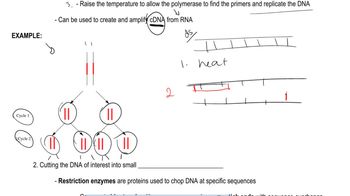From microarray analysis, how do we know what genes are being expressed in a specific tissue?
Table of contents
- 1. Introduction to Genetics51m
- 2. Mendel's Laws of Inheritance3h 37m
- 3. Extensions to Mendelian Inheritance2h 41m
- 4. Genetic Mapping and Linkage2h 28m
- 5. Genetics of Bacteria and Viruses1h 21m
- 6. Chromosomal Variation1h 48m
- 7. DNA and Chromosome Structure56m
- 8. DNA Replication1h 10m
- 9. Mitosis and Meiosis1h 34m
- 10. Transcription1h 0m
- 11. Translation58m
- 12. Gene Regulation in Prokaryotes1h 19m
- 13. Gene Regulation in Eukaryotes44m
- 14. Genetic Control of Development44m
- 15. Genomes and Genomics1h 50m
- 16. Transposable Elements47m
- 17. Mutation, Repair, and Recombination1h 6m
- 18. Molecular Genetic Tools19m
- 19. Cancer Genetics29m
- 20. Quantitative Genetics1h 26m
- 21. Population Genetics50m
- 22. Evolutionary Genetics29m
15. Genomes and Genomics
Functional Genomics
Problem 5
Textbook Question
What are the advantages and disadvantages of using insertion alleles versus alleles generated by chemicals (as in TILLING) in reverse genetic studies?
 Verified step by step guidance
Verified step by step guidance1
Understand the context of reverse genetics: Reverse genetics involves studying the function of a gene by analyzing the phenotypic effects of specific gene alterations. The two approaches mentioned—using insertion alleles and chemically induced alleles—are methods to create these alterations.
Explain insertion alleles: Insertion alleles are created by inserting a piece of DNA (e.g., a transposon or T-DNA) into a gene, disrupting its function. This method is precise because the insertion site can be identified, and the disrupted gene can be directly linked to the observed phenotype.
Discuss the advantages of insertion alleles: Insertion alleles allow for easy identification of the mutated gene using molecular techniques like PCR. Additionally, the inserted DNA can sometimes include reporter genes or selectable markers, facilitating further studies.
Explain chemically induced alleles (TILLING): TILLING (Targeting Induced Local Lesions in Genomes) uses chemical mutagens, such as EMS (ethyl methanesulfonate), to induce random point mutations in the genome. These mutations can be identified through high-throughput screening methods.
Compare disadvantages: Insertion alleles may disrupt regulatory regions or cause unintended effects due to the insertion. On the other hand, chemically induced alleles are random and may require extensive screening to identify mutations in the gene of interest. Additionally, chemical mutagenesis often results in point mutations, which may not completely knock out gene function, making it less definitive than insertion alleles in some cases.
 Verified video answer for a similar problem:
Verified video answer for a similar problem:This video solution was recommended by our tutors as helpful for the problem above
Video duration:
1mPlay a video:
Was this helpful?
Key Concepts
Here are the essential concepts you must grasp in order to answer the question correctly.
Insertion Alleles
Insertion alleles are genetic variants created by the insertion of DNA sequences into a specific location in the genome. This method can lead to gene disruption or modification, allowing researchers to study gene function and phenotypic effects. The advantages include targeted changes and the potential for stable expression, while disadvantages may involve unintended effects on neighboring genes or regulatory elements.
Recommended video:
Guided course

New Alleles and Migration
TILLING (Targeting Induced Local Lesions in Genomes)
TILLING is a reverse genetics technique that uses chemical mutagens to induce random mutations in the genome, followed by screening for specific mutations. This method allows for the identification of alleles with subtle changes, such as point mutations, which can be beneficial for studying gene function. However, the random nature of TILLING can lead to off-target effects and may require extensive screening to find desired mutations.
Recommended video:
Guided course

Induced Mutations
Reverse Genetics
Reverse genetics is an approach that starts with a known gene and seeks to understand its function by analyzing the phenotypic effects of specific mutations. This method contrasts with forward genetics, which begins with a phenotype and works backward to identify the responsible gene. In the context of insertion alleles and TILLING, reverse genetics helps researchers determine how specific genetic changes influence traits, guiding breeding and genetic engineering efforts.
Recommended video:
Guided course

Genetic Cloning
Related Videos
Related Practice
Textbook Question
314
views


